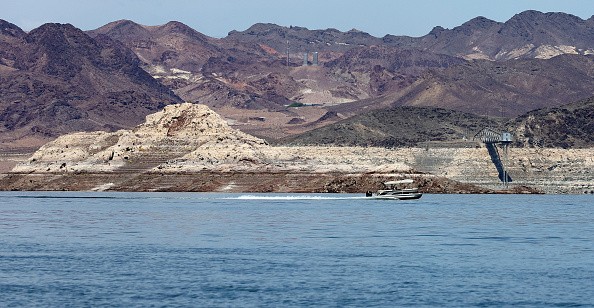Lake Mead's water level has dropped to 1,040 feet, bringing it even closer to the dead-pool threshold.
Because of the continuous drought in the western United States, Lake Mead, a reservoir built by the Hoover Dam on the Colorado River, has been draining up. It runs across Nevada and Arizona.
Lake Mead had dropped to 1,040 feet as of July 28 at 4 a.m. local time, according to fresh Lakes Online statistics. The Lake was at 1,066 feet at the start of 2022.
Lake Mead water decline

Over the previous several years, the levels have significantly declined. Levels were at 1,090 in the beginning of 2020, and 1,083 at the beginning of 2021.
Water flowing over the Hoover Dam generates power for hundreds of thousands of people in the surrounding area.
However, if the drought persists and the water levels drop, there is a risk that the dam's turbines may no longer be able to generate power.
Experts are concerned as the lake continues to sink approaching the dead-pool level.
Steph McAfee, an associate professor and Nevada State climatologist at the University of Nevada, Reno, previously told Newsweek that if Lake Mead hit 895 feet, water would no longer "flow through the dam anymore," which is termed dead-pool level.
Rising temperatures, according to a number of scientific articles, are limiting the amount of water flowing down the Colorado River and into Lake Mead.
Parks Williams and colleagues published two studies claiming that climate change is not responsible for half of the drought.
According to the data, there would still have been a drought without higher temperatures, but not as severe, she added.
The United States According to Drought Monitor, more than 20% of land in the western United States is under "severe or exceptional drought" as of March 8, 2022. Lake Mead's water levels haven't been this low since 1937.
While it is not the only body of water affected, Lake Mead has gained international attention owing to the odd discoveries being made as the water evaporates.
Human skeletal remains were discovered in the bottom of a barrel in May, when the Lake's bottom became revealed. The remains were thought to be those of a gunshot victim from the mid-1970s or early 1980s.
Lakes are disappearing
Lake Urmia in Iran has become the latest lake to be designated as being under serious threat from climate change, but it is just the latest in a long series of such disappearances.
Some, such as the dwindling Aral Sea, can be linked to poorly planned irrigation plans. However, the causes are less evident for others.
According to a recent United Nations Environment Programme (UNEP) report, examinations of Iran's Lake Urmia revealed a seven-meter drop in water levels between 1995 and 2011.
The major reason for the lake drying up is drought induced by climate change, which has impacted the inflow to the lake, resulting in a 65 percent fall in water levels, as per Climate Change News.
An increased diversion for irrigated farmland, dam construction, and decreased rainfall over the lake's surface are all mentioned as contributory reasons.
Scientists have cautioned that the continuous decrease of Lake Urmia might have far-reaching consequences for the region.
These include a changing local temperature, which is affecting agriculture, livelihoods, and health, increasing water salinity, damaging ecosystems, and wetland habitats, and increasing the likelihood of wind-blown salt storms.
The narrative of Lake Urmia, on the other hand, is not new, and comparable examples may be found in lakes and rivers on every continent.
Related article: World War II Boat Emerges as Waters at Lake Mead Declines
© 2025 NatureWorldNews.com All rights reserved. Do not reproduce without permission.





